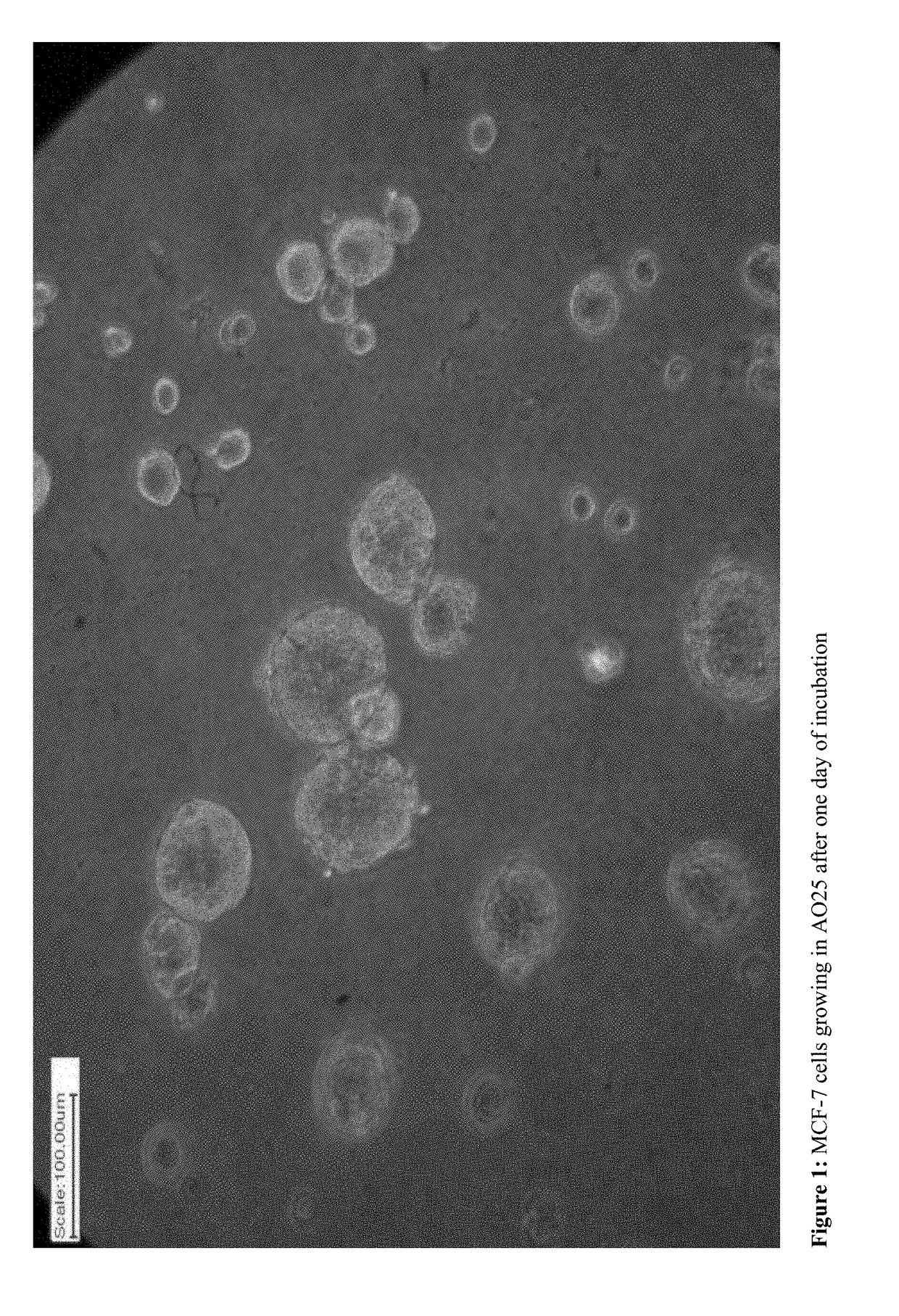Polymers for Inducing 3D Spheroid Formation of Biological Cells
a technology of biological cells and polymers, applied in 3d culture, tumor/cancer cells, biochemistry apparatus and processes, etc., can solve the problems of time-consuming and laborious pre-coating of the plates needed to develop spheroids using the forced-floating method, and the cost of pre-coating plates is added to the researcher's projects,
- Summary
- Abstract
- Description
- Claims
- Application Information
AI Technical Summary
Benefits of technology
Problems solved by technology
Method used
Image
Examples
example 1
M-Co-Acrylic Acid) (AO14)
[0102]After synthesis, the Example thermogel was characterized as described above with the following results:
[0103]Rheological
[0104]The viscosity of Example 1 for a 1% (w / v) solution was found to be 0.07059 Pa·s in water at 5° C. The rheological G′ for example 1% in water hit a maximum of 0.1 Pa at 45° C. The gelation properties of AO14 were separately found to be dependent on pH with a favoring of gelation at low pH values.
[0105]HNMR
[0106]The HNMR spectra of Example 1 indicates peaks at following locations and intensities in following format location ppm (intensity, description): 1.0 ppm (100.00, broad), 1.5 ppm (34.76, broad), 2 ppm (18.11, broad), 2.7 ppm (0.19, single), 3.6 ppm (0.11, single), 3.8 ppm (16.45, broad), 7.7 ppm (2.14, broad). These results are consistent with the indicated polymer indicating successful synthesis.
[0107]FTIR
[0108]The FTIR spectra indicated a broad peak at 3500-3300 cm−1, a sharp triplet peak at 2900-2700 cm−1, strong absorpti...
example 2
onic F127-Urethane) (AO20)
[0114]After synthesis, the Example thermogel was characterized as described above with the following results:
[0115]Rheological
[0116]For rheological testing a 10% w / v solution was generated in cold water. This solution was first tested for viscosity which was found to be 0.1018 Pa·s at 5° C. Upon temperature ramping the maximum gel strength obtained was a G′ of 4000 at 45° C. with onset at 27.5° C. The G′ at 37° C. was 1500 Pa.
[0117]HNMR
[0118]HNMR spectra was collected from polymer dissolved in Deuterated water. The HNMR spectra of Example 2 indicates peaks at following locations and intensities in following format “location” ppm (intensity, description): 1.2 ppm (0.75, broad), 1.7 ppm (16.03, broad), 1.9 ppm (100.00, broad), 2.1 ppm (1.07, broad), 2.4 ppm (0.46, broad). These results are consistent with the indicated polymer indicating successful synthesis.
[0119]FTIR
[0120]The FTIR spectra indicated a broad peak at 3500-3300 cm−1, a strong peak at 3000-2700 ...
example 3
Modified Methylcellulose (AO25)
[0130]After synthesis, the Example thermogel was characterized as described above with the following results:
[0131]Rheological
[0132]Example 3 was dissolved 5% w / v in distilled water and tested by rheology. The viscosity of the 5% w / v solution at 5 C was 0.1742 Pa·s. The maximum G′ reached was 80 Pa at 45° C. with onset at 35° C.
[0133]HNMR
[0134]The HNMR spectra of Example 3 indicates peaks at following locations and intensities in following format “location” ppm (intensity, description): 1.0 ppm (0.58, doublet), 2.7 ppm (44.30, broad), 3.0 ppm (8.70, broad), 3.3-4.0 ppm (100.00, broad), 4.7 ppm (9.33, broad). These results are consistent with the indicated polymer indicating successful synthesis.
[0135]FTIR
[0136]The FTIR spectra indicated a broad peak at 3600-3300 cm−1, a weak peak at 2900 cm−1, a strong peak at 1200-1000 cm−1, and a weak peak at 900 cm−1. These results are consistent with the indicated polymer indicating successful synthesis.
[0137]Cell ...
PUM
| Property | Measurement | Unit |
|---|---|---|
| diameters | aaaaa | aaaaa |
| diameters | aaaaa | aaaaa |
| diameters | aaaaa | aaaaa |
Abstract
Description
Claims
Application Information
 Login to View More
Login to View More - R&D
- Intellectual Property
- Life Sciences
- Materials
- Tech Scout
- Unparalleled Data Quality
- Higher Quality Content
- 60% Fewer Hallucinations
Browse by: Latest US Patents, China's latest patents, Technical Efficacy Thesaurus, Application Domain, Technology Topic, Popular Technical Reports.
© 2025 PatSnap. All rights reserved.Legal|Privacy policy|Modern Slavery Act Transparency Statement|Sitemap|About US| Contact US: help@patsnap.com

